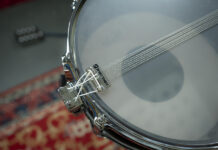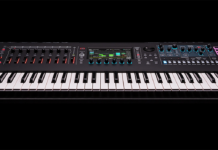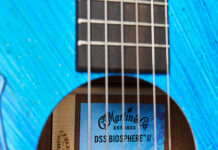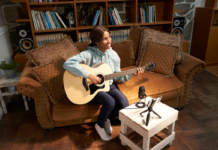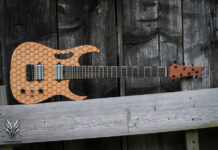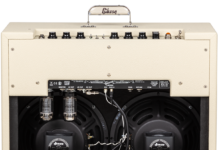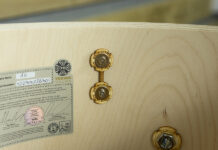
Adrian Belew Discusses Gizmodrome, Parker Guitars and Auditioning for Frank Zappa
Your work is a through-line for some of my favorite music: Frank Zappa to David Bowie to Talking Heads to King Crimson. Apart from good taste in guitarists, what would you say those artists had in common? —Jeff Niemczura
They’re innovators, and so are people like Paul Simon and Nine Inch Nails. So many of the people that have been drawn to me—and who’ve had me work with them—are the kind of artists I’d naturally love, because that’s the kind of music I’m drawn to. I think what we have in common, and I’ll include myself in this since I’ve worked with all these people, is that we’re trying to take music and move it forward and not just stay in one place with it. Every one of those artists you mentioned has their own unique way of approaching music, and I just happen to be one of those people who has enough flexibility that I can fit into any of those packages.
How did Gizmodrome come together, and how would you describe its sound? —Damien Linotte
The last couple of summers, I’ve been in contact with a keyboard player named Vittorio Cosma and a producer named Claudio Dentes about a project in Milan with Stewart Copeland [of the Police]. Eventually I found out Stewart and Vittorio had been doing this for about 10 summers, just getting together, finding a reason to play—just so they could hang out in Italy and eat pasta. By the time I could do it, it had changed to something a little more organized; they’d been offered a record deal from Germany. Without letting me know they were hoping I would join a band with them, they got me to come over.
I thought I was gonna play on four tracks—you know, come in, be in the control room and add guitar. But when I got there, I realized, nope, this is something else. We were set up in a large studio, we could see each other, hear each other, talk to each other, and we started right in doing basic tracks. I was having fun, and I loved the people in the band, so I wasn’t too concerned about it. It took about two or three days before I realized, Hey, this is really good. So that’s how I fell into it.
I wasn’t thinking I’d be in another band; I’ve got the Power Trio, which I’ve had for 11 years. But this was something different. How would I describe the sound? I couldn’t possibly do that, but it’s funky, it’s groovy, it’s happy, it’s joyful, it’s played by guys who know how to play. [laughs] I think it’s a feel-good kind of record.
I read an interview with you years ago where you discussed a new tuning. It was right around Twang Bar King [1983] and Three of a Perfect Pair [King Crimson, 1984]. Robert Fripp had started using his new standard tuning, but you were doing something else, a simple alteration. What was it? —Keith McCrea
In the Eighties, I used altered tunings a lot, and Robert used standard tuning. So, even on records like “Heartbeat” or something like that, you can play it in standard tuning but it’s different. I always would change maybe one or two strings, so it wouldn’t be a very radical change. Then I came up with a very radical tuning I used on a Dobro for many years, and I wrote a record called Desire Caught by the Tail [1986], which was done with that tuning. But by the end of the Eighties, I had decided it was too cumbersome to have so many tunings, especially if you were gonna play those songs live.
King Crimson stopped for a number of years, and in that period, I switched back to standard tuning and Robert made up his “new standard” tuning. So, when we came back together in the Nineties, our roles had kind of reversed. I never did use Robert’s tuning. I tried it once and, well, tunings are relevant to the player. If they ring a note for you and you find some chord shapes, away you go. I couldn’t do that with that tuning. It’s not meant for me.
Have you ever used Brian Eno’s Oblique Strategies in the studio? —Bjorn Lakenstrazen
The only time I actually used them is when we were making [David Bowie’s 1979 album] Lodger. We used them in the studio then. I thought they were kind of fun. You’d draw a card, and it says, “Think green.” Okay, I’m gonna try to think green now. I don’t know how seriously they were supposed to be taken, but we kind of more or less giggled at them. [laughs]
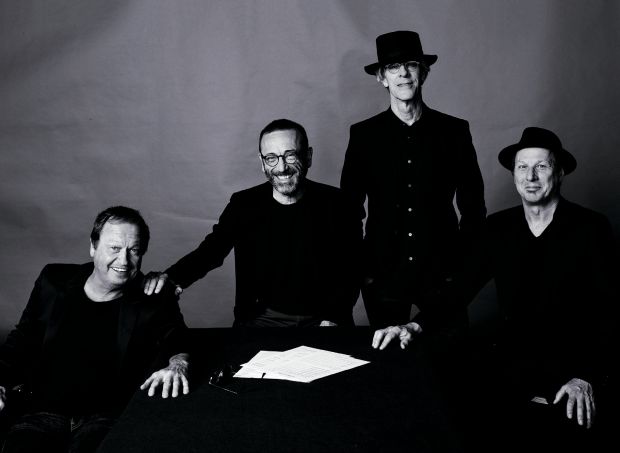
Can you describe your audition for Frank Zappa? I hear it’s kind of a funny story. —Tommy Moore
I flew out to Frank’s house—my first time on a plane. That’s how green I was. They picked me up and took me to his house in the basement, which would turn into his studio over the years. It was just a big empty room. Frank’s sitting behind a console, he’s got a cigarette in his mouth, of course, and there’s a microphone in the middle of the room. Unfortunately, there were people moving things all over; here goes a piano in front of you, they’re setting up something over there and so on. It was very distracting. Frank gave me a long list of songs. I had to borrow the albums from friends because I was so poor.
We started, and he’d say, “Okay, let’s try ‘Andy,’ ” and I’d play it for a minute or two and sing some things, and then he’d stop me, take another puff and say, “Okay, try ‘Wind Up Workin’ in a Gas Station.’ I was fumbling and really being distracted by all the stuff going on. I had nowhere to go, so they were gonna take me back to the airport and fly me back home, so I just watched everyone else’s terrifying auditions. I watched keyboard players and percussionists and thought, “Oh my god, these guys are so great, I don’t know how I’ll ever be in this band.”
There was a moment at the end of the day, though, where it was just Frank and I standing there, and I said, “I’m sorry, I really thought I could do this, and I thought it would be different.” He said, “What do you mean?” I said, “I thought it would just be you and me somewhere quiet where I could show you that I could do this.” So we went up to his living room and sat on his purple couch, I took my little Pignose amp and stuffed it between the pillows so I could turn it up as loud as I could, and we started over. We got about a third of the way through and Frank was starting to sing along with me. Finally he put his hand out, shook my hand and said, “You’ve got the job.” Changed my life, that handshake did.
You started out as a drummer. Does that affect how you play guitar? —Louis-Jules Trochu
Absolutely. I don’t think, for example, I would’ve done that well with Frank [Zappa]’s music had I not had such a rhythmic background. It’s very natural to me. I’ve always been able to play in an odd time signature and shake my booty in 4/4 at the same time and make it groovy, because it’s all a matter of accenting anyway. I also think my time with Frank and my time as a drummer—and I still play drums on my solo records—was important to my being able to write the kind of material I’ve written with King Crimson. Frank was a drummer first too, by the way.
What really led to the end of your involvement with King Crimson? —Ken Brown
Simple! Robert just pulled the plug. [laughs] We had done 10 shows as a five-piece band with new drummer Gavin Harrison along with Pat Mastelotto, and I thought we were gonna continue on from there, and at the end of those 10 shows, Robert seemed to be game for that as well. But within a few weeks, it was over. He said, “I’m not gonna play anymore,” and that was that. When he put together the current lineup, he had something totally different in mind, and he told me it wouldn’t be right for me and I wouldn’t be right for it.
I love your Flux by Belew app. Is there a chance you’ll expand upon any of its musical pieces and make extended versions—or will there just be more Flux in general? —Jim McCurdy
Both, yes. Right now, however, time is not on my side because not only am I getting ready for Gizmodrome, but I’m also being asked to do more Celebrating David Bowie shows next year. But any time I have on my own, I dedicate to Flux. I’m always recording things that can be used as snippets, whether I record them on my iPhone or in the studio. I probably have around 18 songs that I haven’t had time to record. But the idea always was not just new material but taking that material and refashioning it. My thought about music is, how come you do a song and that’s the only life it ever has? That’s it? One arrangement, one version? I think that’s cheating your song. I think what you should do, then, is go back, take another look at it, change it, maybe even change some words, change the style, whatever.
There are songs on Flux that are short because that’s kind of the nature of Flux, but I could see taking them and making them longer arrangements. I have an idea in mind that at some point, I’m going to make a record of the songs from Flux. My first solo vinyl record would be songs from Flux, and it would be full-length songs, more like the Gizmodrome record.
What was your involvement in your signature Parker Maxx Fly guitar? —Craig Jones
When I came into the picture, I was using Strats, but they were modified with Roland GK 13-pin MIDI pickups and Sustainiacs. I asked Ken Parker if there was a way we could put those things in a Parker. He told me that when they first put out the Parker Fly, it was designed to be a MIDI guitar, but they left that out because he was afraid it was too revolutionary. When I approached him, I think he felt, This is the time to do it. I helped them upgrade the electronics. I mean, the guitar was designed in the Eighties, and we’re talking about 10 or 15 years later, so I said, let’s put in the MIDI, keep the piezo, make it so you can get a million sounds. Line 6 had just developed the technology for the Variax, so we said, “Let’s put that in there.” I can’t take any credit, though; I just kind of gave them the problems to solve and they did it.
Source: www.guitarworld.com

